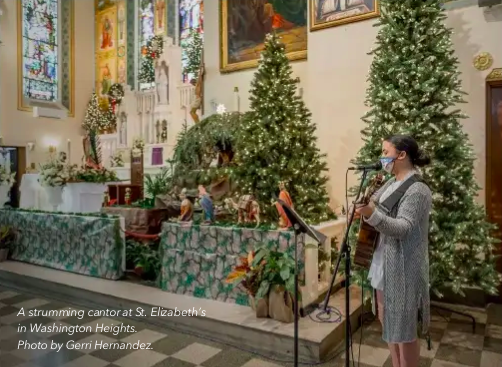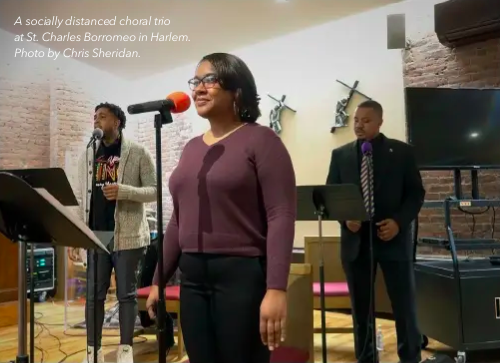Read the full issue of Archways here: http://archny.org/news-events/archways-magazine/
Back in mid-March, when in-person Masses were suspended in New York, parishioners around the archdiocese felt bereft. Among the spiritual “food” most sorely missed, alongside the Eucharist and the simple joy of gathering, was music. We learned that we could not take for granted the uplift provided by the organ (or piano or guitar), the singing of a choir, the congregation joining in. How would we replace these spiritual comforts during a time of social distancing?
At St. Patrick’s Cathedral, home to one of the most magnificent music ministries in America, it was as if someone had hit the mute button. “Since March 15,” music director Dr. Jennifer Pascual says, “every liturgy with music has consisted only of one cantor and one organist. Hymnals and missalettes have been removed from the pews…. The number of Masses has been reduced, and the cathedral choir has not been in session since March 12.”

There is still music at St. Patrick’s, of course, as anyone who tunes in the livestreamed liturgy can attest. It’s reduced in scale, but it is beautiful, professional and often moving. Unfortunately, the majority of those who hear it are listening through small speakers on their computer or TV.
Throughout the archdiocese, music directors consulted with their pastors to determine the best musical solution based on architecture, ventilation and community. In all parishes, the first concern was the safety of parishioners, clergy and choir members. “When the lockdown began after March 14,” says Mark Pacoe, music director at St. John Nepomucene on Manhattan’s East Side, “we continued to livestream the Mass with music. This new reality of how we gather, whether virtually or in person – after June 22 – had to take into account safety measures. As an organist, I’ve continued to provide appropriate music for processions like the offertory, communion or postlude. We have only been singing the necessary or most important responses.”
Other parishes were able to transition to a reduced-size choir soon after in-person Masses returned. In Brewster, “St. Lawrence O’Toole parish did an excellent job of administering to parishioners during the shutdown,” says music director Peter Ryan, “and as such I gratefully received everyone back who wanted to be there and felt safe doing so. We moved our rehearsals to a larger, more secluded space and it worked out well, allowing us to space out. Our choir is smaller now, and that has made it more difficult to learn more difficult repertoire, but other than that we have been able to maintain all of our usual activities.”
At Old St. Patrick’s Cathedral in SoHo, “It was a steep learning curve,” recalls organist and music director Jared Lamenzo. “In the first few months, our choirs and parishioners could not meet in person at all. For Mass, the only ones present in the Basilica were [pastor] Father Graebe, a maintenance person, occasionally an assisting priest, and a cantor in the loft along with me on the Erben organ. With no congregation present, we decided to include more Gregorian chant – for instance, singing the gorgeous Graduals rather than the Responsorial Psalm. We also had processions outdoors with masked singing of the Litany in Time of Pestilence and Plague.”

As restrictions eased, Old St. Patrick’s was able to take advantage of its unique space to bring back choir singing. “In September,” Lamenzo says, “our Schola returned, rehearsing in a large, well-ventilated space, masked and distanced. The loft where we sing is 40 feet above the congregation and very capacious, so it is not a problem to distance ourselves. There have been musical, physical and budgetary challenges, but it has been a joy to sing together again at Mass.”
During a “normal” year, the vibrant music ministry of St. Charles Borromeo in Harlem has four choirs in rotation, including the 40-member Gospel Lites, the Mighty Men Ensemble of St. Charles, the Youth Ensemble and the young-adult Praise & Worship Ensemble. “It has taken some adjusting during this year’s pandemic,” music director Dr. Br’Von Neal says. Formerly, “the Gospel Lites choir would Sing on their designated Sunday at full capacity, but since our return into the church it has been reduced to a trio rotation – one soprano, one alto, one tenor – to render music for a particular Sunday. We elected to do this for all of the ensembles, so that our congregation could still feel a sense of normalcy during such un-normal times.”

At Christmas, most music directors tried to make cautious enhancements in a nod to the accustomed pageantry. At St. Patrick’s, two trumpeters and a timpanist added majesty to the midnight Mass, along with mezzo-soprano Isabel Leonard from the Metropolitan Opera, who sang “O Holy Night.” St. John Nepomucene added a vocal quartet at the Christmas Eve Mass and a trumpeter on Christmas morning. The Schola at the Basilica of Old St. Patrick’s Cathedral moved its annual Concert of Carols from the altar to the loft for Christmas Eve, and during advent recorded a Christmas concert on the Rendever virtual reality platform that created an immersive experience for thousands of seniors in North America and Australia.
As we begin 2021, there is hope that newly approved vaccines will enable music ministries to return to pre-pandemic practices by year’s end. At press time, however, a surging rate of infections and deaths suggests that precautions will be necessary well into the year, quite possibly past Easter. St. John Nepomucene’s Marc Pacoe takes a cautious approach. “I believe the full return to ‘normal’ ministry will be a gradual evolution,” he says. “Returning to singing special anthems and simply having people in the loft again will be a growing and fitting musical celebration over time.”
Reflecting on the experience of 2020, Peter Ryan of St. Lawrence O’Toole says, “We’ve all become much more grateful for what we do have. My choir has taken increasingly greater amounts of time to pray together and for one another at the end of every rehearsal. While this is less musical in nature, I think it’s equally important.”
Thinking ahead to how the parish might celebrate the lifting of restrictions, he says, “Maybe we will celebrate heavily, or maybe we will simply return to normal and hold the attitude that the church never left our parishioners – and never will – because that is a promise St. Lawrence O’Toole intends to keep.”
Read the full issue of Archways here: http://archny.org/news-events/archways-magazine/
